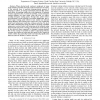116 search results - page 7 / 24 » Maneuverable Relays to Improve Energy Efficiency in Sensor N... |
TWC
2008
13 years 7 months ago
2008
Using relays in wireless networks can potentially lead to significant capacity increases. However, within an asynchronous multi-user communication setting, relaying might cause mor...
WCNC
2010
IEEE
13 years 11 months ago
2010
IEEE
—When shortest path routing is employed in large scale multi-hop wireless networks, nodes located near the center of the network have to perform disproportional amount of relayin...
TPDS
2002
13 years 7 months ago
2002
Sensor webs consisting of nodes with limited battery power and wireless communications are deployed to collect useful information from the field. Gathering sensed information in an...
EWSN
2004
Springer
14 years 7 months ago
2004
Springer
Directed diffusion is a prominent example of data-centric routing based on application layer data and purely local interactions. In its functioning it relies heavily on network-wid...
EWSN
2008
Springer
14 years 7 months ago
2008
Springer
Clustering is an important mechanism in large multi-hop wireless sensor networks for obtaining scalability, reducing energy consumption and achieving better network performance. Mo...

